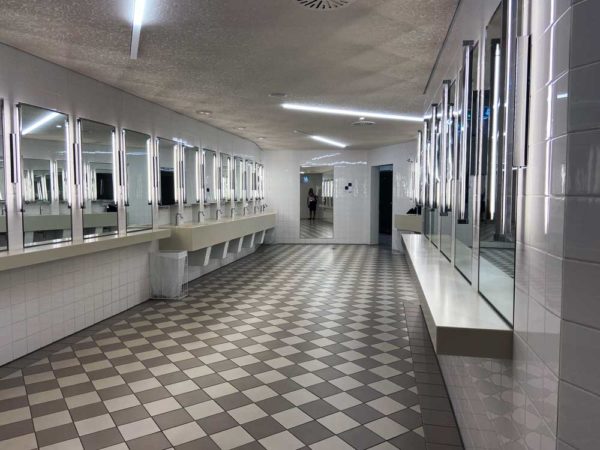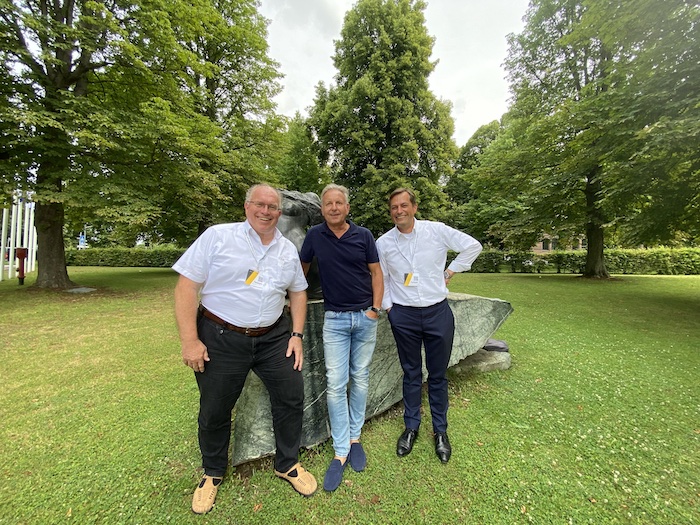At the 26th International Automotive Electronics Congress 2022 in Ludwigsburg, the top industry event for electronics experts and decision-makers in the automotive sector, the focus was on the path to the software-defined car. What does it take in the automotive industry to develop the software-defined car safely, efficiently and sustainably? What are the automotive industry’s current pain points in this multi-layered challenge? What role do regulations play? Do we need cross-border standards to get there? And what role do consumer experiences play? How are the individual players in the automotive industry meeting the current challenges, and why are open source approaches and cooperation particularly important now? Many questions, but also controversial discussions, characterized the traditional congress at the Forum am Schlosspark. Despite many answers, also many questions remained unanswered. The conclusion: There is still a lot to do!
The software-defined car
Up to now, software has been and still is to a large extent very closely linked to the hardware module or electronic control unit (ECU) in the vehicle, which takes over a very specific functionality there. In the “traditional car”, the software hardly evolved during the life of a vehicle and any necessary updates required a visit to the workshop. In the software-defined car, functions are defined by the software rather than the specific hardware modules, similar to applications we run on our smartphones or computers. This allows the functions to evolve and improve throughout the life of the vehicle and even add new functions and features as necessary within the hardware limits. With the software-defined vehicle, new features and services or apps are enabled in the vehicle as needed, either individually or for a limited time. This creates multiple opportunities for new business models, and software-as-a-service becomes tangible for car users. The value of a vehicle can even be increased during its life cycle by adding features at a later stage. Manufacturers’ focus on user experience is becoming a critical success factor. Data can be transmitted over-the-air (OTA), the vehicle can communicate with the infrastructure, collect and send data to the cloud, and receive data. Mobility services, automated driving and the further development of e-mobility are only made possible by software. So the car continues to evolve into a software-centric electronic device on wheels. This no longer has much to do with the original way an automobile worked. The automotive industry is still in the midst of transformation and must open itself up to an even greater extent to market participants from and cooperations with the software and communications industry.
The most important topics and statements of the speakers
After the opening by Alfred Vollmer, Editor-in-Chief of “Automobil-Elektronik” and initiator of the Automotive Electronics Congress, Ricky Hudi took over the moderation and handed over to the first speaker of the day, Porsche CEO Oliver Blume, who spoke about Porsche’s vision of the future and appealed to the emotions of the audience. In this regard, when it came to software-defined vehicle, the use of an open operating system that works with AI and enables the vehicle to connect to different ecosystems around the world was particularly important to him. He also clearly stood for the recognition of the human factor and emphasized the importance of bringing employees along in the transformation and placing them at the center of concepts for success. After all, he said, the transformation cannot be mastered without motivated employees who share the company’s vision and brand values and understand and internalize the necessary steps on the way to the software-defined vehicle.
The future strategy at Mercedes-Benz was the focus of the keynote speech by Magnus Österberg, Head of Software at the Stuttgart-based automaker. It became quite clear: Mercedes-Benz claims market leadership in the luxury segment. The new MB.OS operating system (to go into series production in 2024) and the software development center in Sindelfingen play a decisive role in achieving the ambitious goals. However, Österberg was also critical: “We are leaders in the field of electrical engineering, but there is still a long way to go before we become market leaders in the field of software.”
The world’s largest automotive supplier has managed the transformation from a pure hardware company to a software company, said Mathias Pillin (President Cross Domain Computing Solutions at Bosch). Today, however, the biggest challenge of a Tier 1 is to make it clear to the OEM that not only hardware, but also software has an independent value. It is the software, he said, that makes it possible to process data from a connected vehicle in the quantity and quality to provide individual services and functions.
Dipti Vachani, SVP Automotive and IoT at arm, sees an interplay between hardware and software: “Software-defined vehicles need specific computing power and hardware tailored to the workload of the car. To achieve this, software development today must be integrated into the vehicle development process at a very early stage and meet different demands for performance and compatibility. This compatibility across the entire vehicle is and remains a major challenge for manufacturers. For her, the interlocking further development of hardware and software is the top priority.
Panel discussion “Semiconductors: The Base of the Software-defined Car”.
Moderated by Alfred Vollmer (Automotive Electronics), Jens Fabrowsky (Bosch), Calista Redmond (RISC-V International), Dipti Vachani (arm), Lars Reger (NXP) and Magnus Östberg (Mercedes-Benz), discussed the position of semiconductors in the automotive sector. Commenting on the reports and rumors that OEMs are now building their own chips, Lars Rieger of NXP said, “Let’s dispel the myths a bit. Tesla gets 99% of its chips from companies like us. All they have done is develop an AI accelerator.” And on semiconductor shortages, he commented, “98% of all automotive semiconductors will be above 20 nm in the next 15 years.” Arm’s Dipti Vachani emphasized that innovation has not slowed down due to Corona and that the industry is moving like never before. Magnus Östberg argued that the industry should become more professional in dealing with risks. All the panelists were equally clear that scaling must become the focus of attention.
User experience as a central feature of the software-defined vehicle
The vehicle as the ultimate mobile device: a major topic at the congress. According to Stephan Durach, SVP Connected Company Development at BMW, hardware is increasingly taking a back seat, while intuitive, natural interaction in the car is becoming more and more important. At BMW, this is implemented in the form of a virtual assistant or intelligent navigation. However, it would remain exciting to see what would happen with Apple’s Car Play system, for example, should conflicts of interest arise on the subject of user interface.
When it came to the topic of user experience, three speakers were very much in agreement: Dirk Walliser, SVP Corporate Research & Development at the ZF Group, got to the heart of the matter in his very interesting presentation. The software-defined vehicle is much more than just software. It is much more about the user experience. As far as the cost structure is concerned, however, it is still not clear who will bear the costs for additional software functions in the future: The OEM or the customer?
At Harman International, the focus is also on the consumer experience. For Christian Sobottka, President of the Automotive Division, customers rightly expect to find everything they use on their smartphones in their cars within a very short time. And Riclef Schmidt-Clausen, SVP Domain Intelligent Cockpit & Body at Cariad, noted that smartphone manufacturers clearly still lead the way in user experience. Reaching this level in the automotive industry is a major challenge, he said.
Collaboration as the key to success?
Christoph Hartung (ETAS) spoke about how this challenge could be solved quickly in his presentation, which also contained quite provocative statements: There is no more hierarchical industry than the automotive industry, and AUTOSAR (an initiative to create an open software architecture for ECUs) was founded in 2003 because the industry was “deep in the sh***” at that time. Currently, we are again in a similar situation with the further development of the user interface in the software-defined vehicle, says Hartung – but the willingness to cooperate is basically there in the industry. Karsten Michels, Head of Productline at Continental Automotive, put it similarly, but less provocatively: “Collaboration is the key, we’re all in the same boat.”
Calista Redmond, CEO of RISC-V International brought the topic of open source collaboration model to the stage with a lot of enthusiasm. RISC-V is a free and open ISA that aims to enable a new era of processor innovation through open standards collaboration.
Other presentations by top-notch speakers on exciting insights enriched the congress.
The setting and the atmosphere
For the 26th time already, the doors of the congress opened, which every year is the central meeting point for almost 600 industry experts, mainly from the automotive electrics/electronics sector. The “Great Reunion of the Industry”, as the congress is also fondly called, takes place at the Forum am Schlosspark in Ludwigsburg. For the first time, the event was held exclusively in English – whether this contributed to the quality of the congress is something we at magility critically question. Criticism was also voiced among the participants that with a proportion of German-speaking visitors of certainly at least 90%, a great deal was “lost in translation”. Visitors were able to visit the accompanying trade exhibition before the lecture rooms and find out about the latest developments from exhibitors in the industry live and make contacts. At the culinary networking event in the evening in the neighboring riding hall, the mood was relaxed; many finally saw each other in person for the first time after two years of pandemic.
We were struck this year by the slight increase in the number of female visitors, both on and off stage. With a share of about 3% of the total number of visitors, however, there is still plenty of room for improvement!

The number of female attendees was clearly reflected in the visit to the ladies’ toilets. Conclusion: At this congress the men have to queue 😉
magility Insights
We from magility met many business partners at the congress, had interesting conversations and were pleased to be able to network in person again. As always, the congress was smoothly organized. Thematically, it was more about “in the vehicle” and less about networking and infrastructure, which plays an equally important role in the software-defined vehicle for us at magility. The topic of fleet clearly came up short for us and the subject matter of the speakers has changed only minimally from the time before Corona. Cooperations are important, almost all participants agreed on that. This was also the case before Corona. However, few cooperations were presented this year, which may be an unintended side effect of the Corona pandemic with its contact restrictions.
For us from magility, the presentation by Huawei was very impressive, in which it was explained what has already been implemented and achieved there in the last 3 years. Huawei introduced its first electric car Seres Huawei Smart Selection SF5 only last year and the speed with which Huawei is on the move in the further development of intelligent automotive solutions should shake up all other market players. In their presentations the German companies talked even more about what should be implemented.
The road to the software-defined vehicle is without a doubt one of the key challenges for the German automotive industry that needs to be tackled with verve and without delay. Here in the Stuttgart metropolitan region, we have the best prerequisites for helping to shape the mobility of the future on a solid basis if we approach the new market participants with an open mind, see cooperation as an opportunity, and rely at least in part on uniform software development. Not everyone has to cook their own soup. But together we have the chance to turn the soup into a star menu! Let’s do great things together! We at magility are happy to help!













